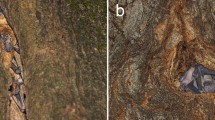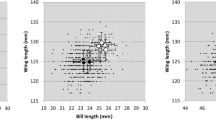Summary
The annual variation in age and sex ratio among raptors passing the Falsterbo peninsula, Sweden was studied the ten autumns 1986–1995. The analysis encompasses thirteen species with average annual totals of between 25 and 14,000 migrants. In general, raptors occurring in low numbers showed the greatest relative annual variation. One explanation for high variation was the steep increase in the Swedish populations of Red KiteMilvus milvus and Marsh HarrierCircus aeruginosus during the period. A constant high percentage of juveniles may be due to the adults being primarily residents, like in Red Kite and GoshawkAccipiter gentilis, or to a less pronounced tendency of adults to follow leading lines, as in Marsh Harrier, MerlinFalco columbarius and HobbyF. subbuteo. In most other species the ages were represented in more balanced proportions, and the proportion of juveniles most likely reflects variations in breeding results. An average of 41% juveniles in Common BuzzardButeo buteo compared to 23% in the Rough-legged BuzzardB. lagopus indicates a considerably better production in the first species during the ten years. The extremely low average of 11% young Honey BuzzardsPernis apivorus most likely represents a very low production in the period. There was a highly significant correlation in the annual proportion of juveniles between Northern HarrierCircus cyaneus and Rough-legged Buzzard. Most likely this covariation reflects fluctuation in rodent numbers in northern Scandinavia. Most species showed a sex ratio close to 50%. In both Northern and Marsh Harrier there was however a clear dominance of females among the adults, with a ratio of 1.63 and 1.27 females/male respectively.
Zusammenfassung
Die jährliche Variation der Alters- und Geschlechterverhältnisses bei Greifvögeln, die die Halbinsel Falsterbo in Südschweden überfliegen, wurde im Herbst 1986–1995 untersucht. Die Untersuchung umfaßt dreizehn Arten mit jährlich durchschnittlich 25 bis 14.000 ziehenden Vögeln. Die weniger häufigen Arten waren in ihrem jährlichen Auftreten variabler als die häufigen Arten. Ursache dafür ist die starke Zunahme in der schwedischen Population des Rotmilans und der Rohrweihe in dieser Periode. Einen konstant hohen Anteil an Jungvögeln zeigten Arten, bei denen die Altvögel vorwiegend Standvögel sind (z. B. Rotmilan, Habicht) oder Arten, bei denen die Altvögel weniger intensiv Leitlinien folgen, wie Rohrweihe, Merlin und Baumfalke. Bei den meisten anderen Arten waren die Altersklassen mehr ausgeglichen. Bei ihnen spiegelt der jährliche Anteil an Jungvögeln wohl vornehmlich die Brutergebnisse wider. Durchschnittlich 41% Jungvögel beim Mäusebussard verdeutlichen einen besseren Bruterfolg als 23% Jungvogelanteil beim Rauhfußbussard. Mit durchschnittlich nur 11% Jungvögel war der Bruterfolg des Wespenbussards sehr niedrig, und die jährlichen Anzahlen junger Wespenbussarde variierten sehr stark. Zwischen Kornweihe und Rauhfußbussard korrelierten die jährlichen Jungvogelanteile eng. Dies deutet auf Fluktuationen der Kleinsäuger in Nordskandinavien hin, die beide Arten in gleicher Weise beeinflussen. Ähnliches gilt wohl auch für den Merlin.
Die Geschlechterverhältnisse waren bei den meisten Arten ausgeglichen. Bei Kornweihe und Rohrweihe überwogen die Weibchen, mit 1,63 bzw. 1,27 Weibchen pro ziehendem Männchen. Dies dürfte die Folge der bei diesen Arten ausgeprägteren Polygynie sein. Beim Habicht überwogen junge Männchen.
Similar content being viewed by others
References
Ahlén, I. & Tjernberg, M. (1996): Rödlistade ryggradsdjur i Sverige-Artfakta (in Swedish). Artdatabanken, SLU, Uppsala.
Alerstam, T. (1990): Bird Migration. Cambridge.
Arnold, T. W. (1991): Geographic variation in sex ratios of wintering American KestrelsFalco sparverius. Ornis Scand. 22: 20–26.
Balfour, E. & Cadbury, J. C. (1979): Polygyny, spacing and sex ratio among Hen HarriersCircus cyaneus in Orkney, Scotland. Ornis Scand. 10: 133–141.
Belopolskij, L. O. (1971): Migration of Sparrowhawk on Courland Spit. Notaki Ornitologiczne 12: 1–12.
Bengtson, S.-A. (1967): Observations of the reproductive success in 26 nests of the Marsh HarrierCircus aeruginosus in Skåne Province, Sweden. Ool. Rec. 41: 23–28.
Bijlsma, R. G. (1993): Ecological Atlas of the Raptors in the Netherlands. Haarlem.
Clark, W. S. (1985): The migrating Sharp-shinned Hawk at Cape May Point: Banding and recovery results. In: M. Harwood (Ed.): Proceedings of the Fourth Hawk Migration Conference. Rochester, NY: 137–148.
Cramp, S. & Simmons, K. E. L. (1980): The Birds of the Western Palearctic, Vol. 2. Oxford.
Dobler, G., Schneider, R. & Schweis, A. (1991): Die Invasion des Rauhfußbussards (Buteo lagopus) in Baden-Württemberg in Winter 1986/87. Vogelwarte 36: 1–18.
Evans, P. R. & Lathbury, G. W. (1973): Raptor migration across the Straits of Gibraltar. Ibis 115: 572–585.
Forsman, D. (1984): Rovfågelsguiden (in Swedish). Helsingfors.
Génsbøl, B. (1995): Birds of prey of Europe, North Africa and the Middle East. Copenhagen.
Glutz von Blotzheim, U. N., Bauer, K. M. & Bezzel, E. (1971): Handbuch der Vögel Mitteleuropas, Vol. 4. Frankfurt am Main.
Hagen, Y. (1952): Rovfuglene og viltpleien. Oslo.
Hagen, Y. (1969): Norwegian studies on the reproduction of birds of prey and owls in relation to micro-rodent population fluctuations. Fauna 22: 73–126.
Hansson, L. & Henttonen, H. (1988): Rodent Dynamics as Community Processes. Trends Ecol. Evol. 3: 195–200.
Haukioja, E. & Haukioja, M. (1970): Mortality rates of Finnish and Swedish Goshawks (Accipiter gentilis). Finnish Game Res. 31: 13–20.
Hörnfeldt, B. (1994): Smådäggdjursinventeringar i PMK:s referensområden - rapport från verksamheten 1992 (in Swedish). Rapport 4294, Naturvårdsverket.
Kjellén, N. (1992): Differential timing of autumn migration between sex and age groups in raptors at Falsterbo, Sweden. Ornis Scand. 23: 420–434.
Kjellén, N. (1994): Differences in age and sex ratio among migrating and wintering raptors in Southern Sweden. Auk 111: 274–284.
Kjellén, N. (1996a): The Red Kite Project 1995 (in Swedish with English summary). Anser 35: 17–25.
Kjellén, N. (1996b): Riksinventering av brun kärrhök 1995 (in Swedish). Vår Fågelvärld 55: 6–15.
Kjellén, N. (1997): Importance of a bird migration hot spot: proportion of the Swedish population of various raptors seen on autumn migration at Falsterbo 1986–1995 and population changes reflected by the migration figures. Ornis Svecica 7: 21–34.
Mueller, H. C., Berger, D. D. & Allez, G. (1977): The periodic invasions of Goshawks. Auk 94: 652–663.
Newton, I. (1979): Population Ecology of Raptors. Berkhamsted.
Newton, I. & Marquiss, M. (1979): Sex ratio among nestlings of the European Sparrowhawk. Amer. Nat. 113: 309–315.
Österlöf, S. (1977): Migration, wintering areas, and site tenacity of European OspreyPandion h. haliaetus. Ornis Scand. 8: 61–78.
Pasanen, S. (1972): Piekanen ravintobiologiasta Metsä-Lapista (in Finnish). Soum. Riista 24: 10–18.
Poole, A. F. (1989): Ospreys: A Natural and Unnatural History. Cambridge.
Porter, R. & Willis, I. (1968): The autumn migration of soaring birds at the Bosphorus. Ibis 110: 520–536.
Roos, G. (1996): Sträckfågelräkning vid Falsterbo 1993–1994 (in Swedish). Rapport 4359, Naturvårdsverket.
Rudebeck, G. (1950): Studies on Bird Migration. Vår Fågelvärld, Suppl. 1.
Saurola, P. (1995): Finnish OspreysPandion haliaetus in 1971–1994. Vogelwelt 116: 199–204.
SOF (1990): Check-list of Birds of Sweden (in Swedish with notes to foreign readers). Stockholm.
Søgaard, S. & Østerby, G. (1989): Höststräcket av bivråkPernis apivorus vid Falsterbo 1977–86 (in Swedish with English summary). Vå Fågelvärld 48: 191–201.
Stolt, B.-O., Ekström, L., Fransson, T., Malmgren, B., Staav, R., Sällström, B. & Sällström, U. B. (1992). Report on Swedish Bird Ringing for 1990. Swedish Museum of Natural History, Bird Ringing Centre, Stockholm.
Tjernberg, M. & Ryttman, H. (1994): Survival and population development of the Honey BuzzardPernis apivorus in Sweden. Ornis Svecica 4: 133–139.
Ulfstrand, S., Roos, G., Alerstam, T. & Österdahl, L. (1974): Visible Bird Migration at Falsterbo, Sweden. Vår Fågelvärld, Suppl. 8.
Wallin, K., Wallin, M., Järås, T. & Strandvik, P. (1985): Leap-frog migration in the Swedish KestrelFalco tinnunculus population. Proc. Fifth Nordic Orn. Congr. 1985: 213–222.
Watson, D. (1977): The Hen Harrier. Berkhamsted.
Zijlstra, M., Daan, S. & Bruinenberg-Rinsma, J. (1992): Seasonal variation in the sex ratio of marsh harrierCircus aeruginosus broods. Func. Ecol. 6: 553–559.
Author information
Authors and Affiliations
Rights and permissions
About this article
Cite this article
Kjellén, N. Annual variation in numbers, age and sex ratios among migrating raptors at Falsterbo, Sweden from 1986–1995. J Ornithol 139, 157–171 (1998). https://doi.org/10.1007/BF01651225
Accepted:
Published:
Issue Date:
DOI: https://doi.org/10.1007/BF01651225




